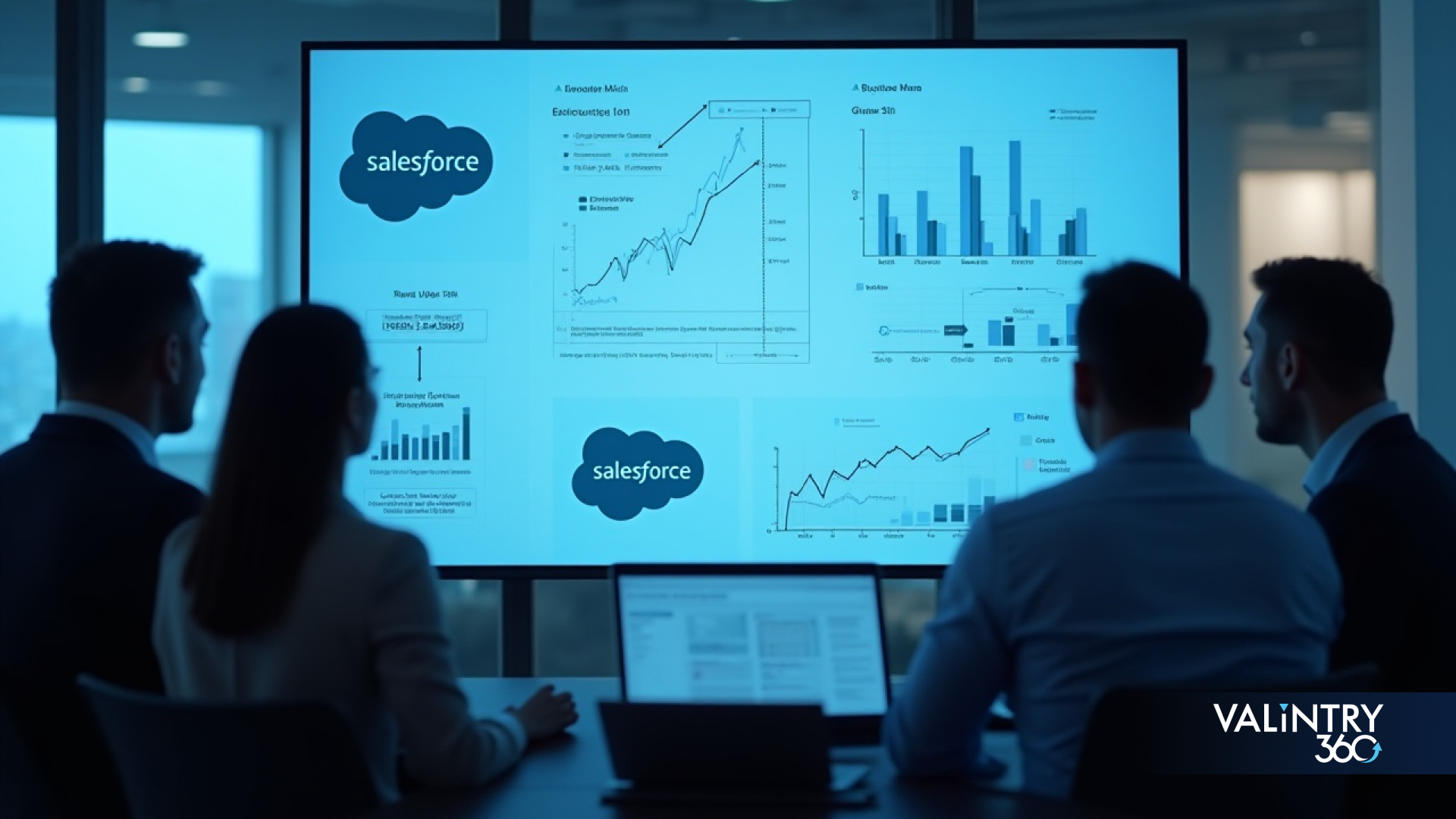
Did you know up to 37% of Salesforce licenses go unused, wasting valuable resources? That’s right — many organizations Many companies overspend without linking Salesforce to real revenue outcomes. With the right account planning strategy, you can turn Salesforce into a true growth engine.In fact, only 63% of licenses are actively used in some businesses, creating a significant drain on resources that could be better allocated elsewhere.Our Salesforce consulting experts help you optimize licenses, align features to your goals, and build a clear roadmap that maximizes ROI and drives measurable business results.
In this guide, we’ll walk you through creating a Salesforce roadmap that directly ties to revenue growth. We’ll help you identify which features actually matter for your business, show you how to build a lean implementation plan, and demonstrate how proper account plans in Salesforce can drive measurable business results. Let’s turn your Salesforce investment into a revenue-generating powerhouse!
Overview
Define Revenue Goals and Map Business Needs
Building an effective Salesforce roadmap begins with establishing clear revenue objectives that directly connect to your business needs. Since profitability requires balancing growth potential with resourcing, costs, and customer expectations, your revenue model must closely align with your business goals.
Identify key revenue drivers in your business
Successful revenue growth demands monitoring specific sales metrics that impact your bottom line. Five critical metrics worth tracking include pipeline volume, average order value, customer churn rate, lead conversion rate, and sales cycle time. Furthermore, understanding your revenue sources is crucial—research shows that 90% of sales teams rely on multiple revenue channels including recurring sales (42%), upsells/cross-sells (31%), and one-off sales (28%).
When implementing account planning in Salesforce, focus on metrics that reveal customer engagement levels, such as adoption rates and satisfaction scores. These indicators help ensure your account plans in Salesforce are working to maintain customer loyalty while supporting sustainable revenue growth.
Audit current Salesforce usage and gaps
Despite Salesforce’s popularity as the world’s leading CRM for 11 consecutive years, approximately 30-70% of implementations fail to meet strategic objectives due to misaligned goals, poor user adoption, or flawed execution. Before creating your roadmap, conduct a thorough audit to:
- Analyze field usage and identify data discrepancies
- Review validation rules and monitor reports/dashboards
- Validate KPIs against business performance data
This assessment process helps identify system errors and functionality bottlenecks, ultimately improving user experience and creating a more mature CRM platform tailored to your specific business requirements.
Align CRM goals with sales and marketing outcomes
Synchronizing your sales and marketing functions through Salesforce account planning delivers measurable advantages. Organizations with effective sales-marketing collaboration experience 70% more revenue growth than businesses with ineffective cooperation. Moreover, aligned teams can achieve up to 20% annual revenue growth, whereas misaligned teams may see a 4% revenue decline.
When CRM and marketing strategies work together through integrated account plans in Salesforce, companies deliver valuable insights that build trust, strengthen relationships, and ultimately increase sales. This coordinated approach ensures your salesforce account plan directly supports your revenue targets while optimizing resource allocation across your entire organization.
Build a Lean Salesforce Roadmap

Creating a lean Salesforce roadmap requires strategic choices about technology, implementation approach, and deployment sequence. After identifying your business needs, the next critical step is selecting the right tools and approach that directly support revenue generation.
Choose the right Salesforce edition for your needs
Salesforce offers four primary CRM editions, each with distinct capabilities and price points. Essentials provides basic CRM functionality for small teams up to 10 users. Professional edition supports growing businesses with automation and customization but without advanced development requirements. Enterprise, the most widely adopted option, unlocks full-scale automation, advanced customization, and robust integration options ideal for mid-market companies. Finally, Unlimited edition provides access to all Salesforce features with premium support and maximum scalability.
Rather than overbuying features you won’t use, focus on your current requirements by selecting the lowest tier that delivers critical functionality. Consider key factors like:
- Current team size and projected growth
- Required automation and integration capabilities
- Budget constraints and ROI expectations
- Industry-specific needs
Use Quickstart packages and avoid overbuying
Quickstart packages offer pre-configured Salesforce solutions that accelerate implementation, often reducing deployment time from months to just 2-4 weeks. These packages deliver up to 60% cost savings compared to traditional CRM projects through:
- Pre-built workflows, dashboards, and industry-specific templates
- Streamlined setup processes focusing on essential features
- Best practices built directly into configurations
Consequently, businesses can achieve faster ROI while maintaining flexibility to expand later. Specifically for account planning in Salesforce, Quickstart packages provide ready-to-use frameworks that align sales activities with revenue targets.
Plan phased rollouts with core modules first
Implementing Salesforce in manageable phases produces better results than attempting everything simultaneously. Initially, audit your current sales and service processes to identify bottlenecks and automation opportunities. Then create a 12-month timeline with quarterly milestones, starting with essential core modules before adding specialized features.
This phased approach delivers several advantages: faster early wins, better user adoption, more flexible spending, and the ability to course-correct before investing in expensive customizations. Ultimately, this methodical implementation ensures your Salesforce account planning directly contributes to revenue growth rather than becoming a costly technology experiment.
Use Account Planning and AI to Drive ROI
Account planning combined with AI creates a powerful engine for driving measurable ROI in Salesforce. Following your lean implementation roadmap, these tools work together to transform your CRM from a record-keeping system into a revenue-generating machine.
Enable and customize Salesforce Account Plans
Account Plans, released in Winter ’25, are now available in all Sales Cloud Enterprise editions and above at no additional cost. Unlike traditional spreadsheets, these native plans live directly within Salesforce, allowing teams to strategically manage key accounts where they already work. After enabling this feature in Setup, you’ll gain access to four new standard objects: Account Plan, Account Plan Objective, Account Plan Objective Measure, and Account Plan Objective Measure Relation.
Set measurable objectives and track progress
Account Plan Objectives provide a structured framework for setting and tracking revenue goals. Each objective can be assigned to specific team members with mandatory start and end dates. Objectives can be measured using currency, percentage, or numerical values, allowing for clear progress tracking directly on the Account Plan record. Plus, the Spring ’25 release introduced Objective Metrics Calculation Definitions that automatically update current values from opportunity, case, and campaign data.
Leverage Agentforce and automation for sales efficiency
Agentforce, Salesforce’s agentic AI layer, has already saved sellers over 50,000 hours through automated call summaries and conversation reports. This technology addresses a critical challenge—sales reps typically spend just 30% of their time actually selling. The SDR Agent component can reduce lead response times by 50% and boost email open rates by 40%. Meanwhile, the Sales Coach Agent offers personalized guidance through virtual role-playing and data-driven insights.
Integrate Slack and Flows for better collaboration
Connecting Salesforce with Slack creates a seamless environment where teams can access CRM data without leaving conversations. This integration allows Agentforce to take Slack-specific actions while leveraging real-time customer data. Teams can make faster decisions with live analytics from Tableau Next and review interaction summaries directly in Slack. Furthermore, you can automate business processes in Slack using clicks rather than code—minimizing administrative overhead for your sales team.
Track, Optimize, and Scale Revenue Impact

To ensure your Salesforce investment directly contributes to revenue growth, you must continuously measure, refine, and scale your implementation. Success requires more than just initial setup—it demands ongoing optimization based on performance data.
Create a 12-month roadmap with quarterly ROI reviews
The most effective Salesforce implementations follow a structured 12-month timeline with regular checkpoints. Begin by auditing your current sales and service processes, identifying bottlenecks, and selecting the appropriate edition. Subsequently, schedule quarterly ROI reviews to assess progress and make adjustments. According to industry data, organizations that conduct regular performance evaluations can identify improvement areas more efficiently, ultimately leading to better strategic decisions.
Use opportunity reports to prioritize high-value ideas
Opportunity management in Salesforce serves as a complete setup that highlights critical details about upcoming deals. Indeed, 76% of users recommend Salesforce as a must-have management tool for revenue growth. The platform’s opportunity reports allow you to quickly identify ideas driving the most revenue by displaying opportunity value by idea stage and plotting ideas by total opportunity value. This prioritization capability helps sales teams focus on promising prospects with the greatest potential.
Refine roadmap based on adoption and performance
Effective Salesforce adoption requires clear goals and metrics beyond basic login counts. Track KPIs like opportunities created, reports run, and data quality. Gather user feedback through surveys, Chatter groups, and polls to understand satisfaction levels. Throughout months 5-7 of your implementation, collect this feedback and optimize based on usage patterns. Prior to making significant investments, conduct digital audits and clean duplicate data to maintain system efficiency.
Conclusion
Building a Salesforce roadmap that fuels revenue growth demands strategic vision, precise execution, and continuous optimization. Start by defining measurable revenue goals and assessing your current usage to ensure every license drives value. Leverage Salesforce’s native account planning, AI, and Slack integration to maximize team performance and sales efficiency. With VALiNTRY360’s expert Salesforce consulting, you gain a tailored roadmap, faster ROI, and a CRM that powers predictable, scalable revenue growth—turning Salesforce into your ultimate competitive advantage.
Related Posts
How Salesforce Data Cloud Evolves into Data 360…
Nearly 80% of enterprise data remains unstructured, and many organizations still find it difficult to access, organize, and extract useful insights from it. This ongoing challenge is exactly what Data 360 is built to solve through its latest phase of…
Sales Engagement in Salesforce: Cadences, Queues & Analytics
B2B selling pipeline velocity depends less on volume and more on precision. Sales Engagement in Salesforce helps revenue teams achieve that precision by combining three powerful pillars: cadences, work queues, and sales analytics. Together, these tools streamline outreach, strengthen rep…
How Marketing Automation Consulting Drives Always-On Salesforce Success
With a daily tech-evolving market now buyers research 24/7 across multiple channels. For mid-market and enterprise teams, that means campaigns must always be “on”—adapting to behavior, intent, and lifecycle stage in real time. Yet, many marketing teams still rely on…

